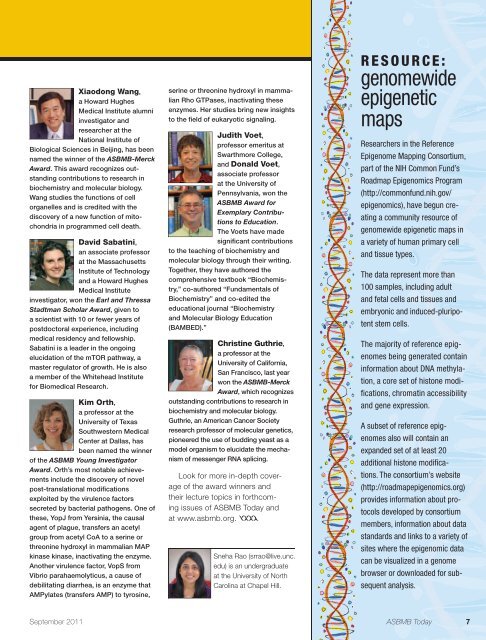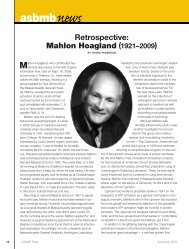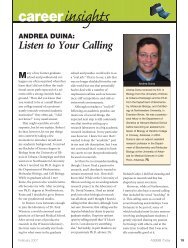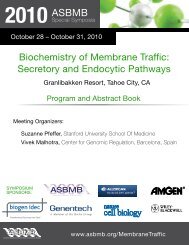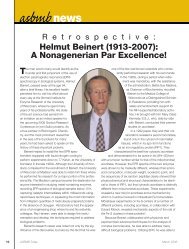asbmbnews
asbmbnews
asbmbnews
You also want an ePaper? Increase the reach of your titles
YUMPU automatically turns print PDFs into web optimized ePapers that Google loves.
Xiaodong Wang,<br />
a Howard Hughes<br />
Medical Institute alumni<br />
investigator and<br />
researcher at the<br />
National Institute of<br />
Biological Sciences in Beijing, has been<br />
named the winner of the ASBMB-Merck<br />
Award. This award recognizes outstanding<br />
contributions to research in<br />
biochemistry and molecular biology.<br />
Wang studies the functions of cell<br />
organelles and is credited with the<br />
discovery of a new function of mitochondria<br />
in programmed cell death.<br />
David Sabatini,<br />
an associate professor<br />
at the Massachusetts<br />
Institute of Technology<br />
and a Howard Hughes<br />
Medical Institute<br />
investigator, won the Earl and Thressa<br />
Stadtman Scholar Award, given to<br />
a scientist with 10 or fewer years of<br />
postdoctoral experience, including<br />
medical residency and fellowship.<br />
Sabatini is a leader in the ongoing<br />
elucidation of the mTOR pathway, a<br />
master regulator of growth. He is also<br />
a member of the Whitehead Institute<br />
for Biomedical Research.<br />
Kim Orth,<br />
a professor at the<br />
University of Texas<br />
Southwestern Medical<br />
Center at Dallas, has<br />
been named the winner<br />
of the ASBMB Young Investigator<br />
Award. Orth’s most notable achievements<br />
include the discovery of novel<br />
post-translational modifications<br />
exploited by the virulence factors<br />
secreted by bacterial pathogens. One of<br />
these, YopJ from Yersinia, the causal<br />
agent of plague, transfers an acetyl<br />
group from acetyl CoA to a serine or<br />
threonine hydroxyl in mammalian MAP<br />
kinase kinase, inactivating the enzyme.<br />
Another virulence factor, VopS from<br />
Vibrio parahaemolyticus, a cause of<br />
debilitating diarrhea, is an enzyme that<br />
AMPylates (transfers AMP) to tyrosine,<br />
serine or threonine hydroxyl in mammalian<br />
Rho GTPases, inactivating these<br />
enzymes. Her studies bring new insights<br />
to the field of eukaryotic signaling.<br />
Judith Voet,<br />
professor emeritus at<br />
Swarthmore College,<br />
and Donald Voet,<br />
associate professor<br />
at the University of<br />
Pennsylvania, won the<br />
ASBMB Award for<br />
Exemplary Contributions<br />
to Education.<br />
The Voets have made<br />
significant contributions<br />
to the teaching of biochemistry and<br />
molecular biology through their writing.<br />
Together, they have authored the<br />
comprehensive textbook “Biochemistry,”<br />
co-authored “Fundamentals of<br />
Biochemistry” and co-edited the<br />
educational journal “Biochemistry<br />
and Molecular Biology Education<br />
(BAMBED).”<br />
Christine Guthrie,<br />
a professor at the<br />
University of California,<br />
San Francisco, last year<br />
won the ASBMB-Merck<br />
Award, which recognizes<br />
outstanding contributions to research in<br />
biochemistry and molecular biology.<br />
Guthrie, an American Cancer Society<br />
research professor of molecular genetics,<br />
pioneered the use of budding yeast as a<br />
model organism to elucidate the mechanism<br />
of messenger RNA splicing.<br />
Look for more in-depth coverage<br />
of the award winners and<br />
their lecture topics in forthcoming<br />
issues of ASBMB Today and<br />
at www.asbmb.org.<br />
Sneha Rao (srrao@live.unc.<br />
edu) is an undergraduate<br />
at the University of North<br />
Carolina at Chapel Hill.<br />
ResouR ce:<br />
genomewide<br />
epigenetic<br />
maps<br />
Researchers in the Reference<br />
Epigenome Mapping Consortium,<br />
part of the NIH Common Fund’s<br />
Roadmap Epigenomics Program<br />
(http://commonfund.nih.gov/<br />
epigenomics), have begun creating<br />
a community resource of<br />
genomewide epigenetic maps in<br />
a variety of human primary cell<br />
and tissue types.<br />
The data represent more than<br />
100 samples, including adult<br />
and fetal cells and tissues and<br />
embryonic and induced-pluripotent<br />
stem cells.<br />
The majority of reference epigenomes<br />
being generated contain<br />
information about DNA methylation,<br />
a core set of histone modifications,<br />
chromatin accessibility<br />
and gene expression.<br />
A subset of reference epigenomes<br />
also will contain an<br />
expanded set of at least 20<br />
additional histone modifications.<br />
The consortium’s website<br />
(http://roadmapepigenomics.org)<br />
provides information about protocols<br />
developed by consortium<br />
members, information about data<br />
standards and links to a variety of<br />
sites where the epigenomic data<br />
can be visualized in a genome<br />
browser or downloaded for subsequent<br />
analysis.<br />
September 2011 ASBMB Today 7


